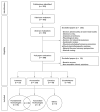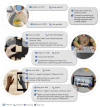Trends and Innovations in Wearable Technology for Motor Rehabilitation, Prediction, and Monitoring: A Comprehensive Review
- PMID: 39771710
- PMCID: PMC11679760
- DOI: 10.3390/s24247973
Trends and Innovations in Wearable Technology for Motor Rehabilitation, Prediction, and Monitoring: A Comprehensive Review
Abstract
(1) Background: Continuous health promotion systems are increasingly important, enabling decentralized patient care, providing comfort, and reducing congestion in healthcare facilities. These systems allow for treatment beyond clinical settings and support preventive monitoring. Wearable systems have become essential tools for health monitoring, but they focus mainly on physiological data, overlooking motor data evaluation. The World Health Organization reports that 1.71 billion people globally suffer from musculoskeletal conditions, marked by pain and limited mobility. (2) Methods: To gain a deeper understanding of wearables for the motor rehabilitation, monitoring, and prediction of the progression and/or degradation of symptoms directly associated with upper-limb pathologies, this study was conducted. Thus, all articles indexed in the Web of Science database containing the terms "wearable", "upper limb", and ("rehabilitation" or "monitor" or "predict") between 2019 and 2023 were flagged for analysis. (3) Results: Out of 391 papers identified, 148 were included and analyzed, exploring pathologies, technologies, and their interrelationships. Technologies were categorized by typology and primary purpose. (4) Conclusions: The study identified essential sensory units and actuators in wearable systems for upper-limb physiotherapy and analyzed them based on treatment methods and targeted pathologies.
Keywords: Parkinson’s; continuous health; physiotherapy; pos-strock; telemedicine; upper limb; wearable.
Conflict of interest statement
The authors declare no conflicts of interest. The funders had no role in the design of the study; in the collection, analyses, or interpretation of data; in the writing of the manuscript; or in the decision to publish the results.
Figures












References
-
- Kamecka K., Foti C., Gawiński Ł., Matejun M., Rybarczyk-Szwajkowska A., Kiljański M., Krochmalski M., Kozłowski R., Marczak M. Telemedicine Technologies Selection for the Posthospital Patient Care Process after Total Hip Arthroplasty. Int. J. Environ. Res. Public Health. 2022;19:11521. doi: 10.3390/ijerph191811521. - DOI - PMC - PubMed
-
- Chong Y.W., Ismail W., Ko K., Lee C.Y. Energy Harvesting for Wearable Devices: A Review. IEEE Sens. J. 2019;19:9047–9062. doi: 10.1109/JSEN.2019.2925638. - DOI
Publication types
MeSH terms
Grants and funding
- UIDB/05549/2020, UIDP/05549/2020, CEECINST/00039/2021, LASI-LA/P/0104/2020/FCT/MCTES
- Innovation Pact HfFP - Health From Portugal, co-funded from the "Mobilizing Agendas for Business Innovation" of the "Next Generation EU" program of Component 5 of the Recovery and Resilience Plan (RRP), concerning "Capitalization and Business Innovation",/Innovation Pact HfFP - Health From Portugal, co-funded from the "Mobilizing Agendas for Business Innovation" of the "Next Generation EU" program of Component 5 of the Recovery and Resilience Plan (RRP), concerning "Capitalization and Business Innovation",
LinkOut - more resources
Full Text Sources

